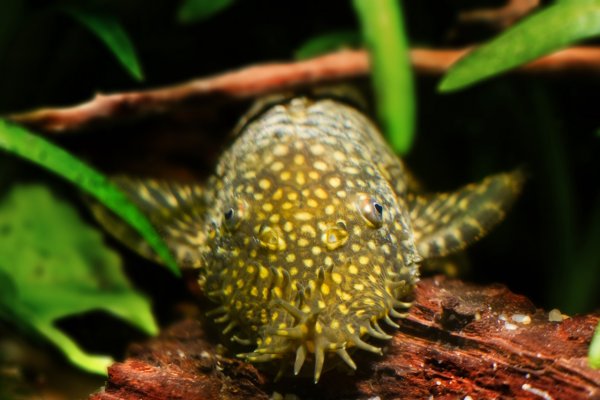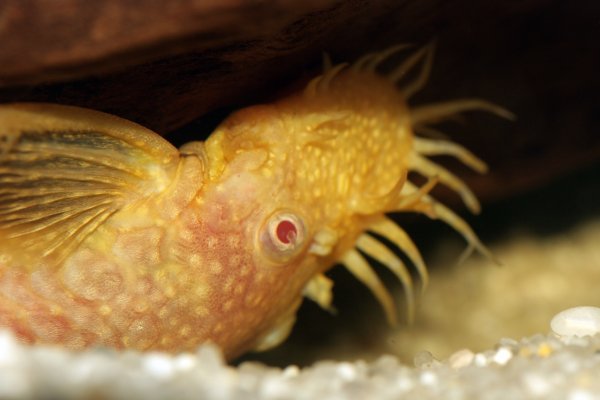You can find Bristlenose Pleco in almost every aquarium as they are hardy and smaller than the Common Pleco. Bristlenose Plecostomus (Ancistrus sp.) is also common because they keep the tank clean by eating the algae.
There are many other names of Bristlenose Pleco. Some of them are Bushynose Catfish, Bristlenose Catfish, Brushmouth Pleco, and the Common Bristlenose Catfish. No one can beat Bristlenose plecos in hiding or tank cleaning.
Here is the short overview of Pleco that you should keep in mind before discussing more them.
| Category | Rating |
|---|---|
| Family | Loricariidae |
| Care Level | Easy |
| Color Form | Brown, Albino, Grey, Black |
| Lifespan | 5+ Years |
| Temperament | Peaceful |
| Size | Up to 5 inches |
| Diet | Omnivorous but mostly have plants |
| Tank Set-Up | Plenty of Caves and Hiding Spaces |
| Minimum Tank Size | 25 Gallons |
Bristlenose Pleco Care Guide
Bristlenose Pleco Appearance

One of the interesting things about Bristlenose is that they can sit motionless for hours and can easily blend in their natural habitat. They can be found in black, grey, olive, or brown color and their upper body is darker than their lower body. Also, their body can be seen covered in light white or yellow dots.
Bristlenose catfish are small in size and can grow up to 3-5 inches. They can be distinguished from Common Pleco by their flat and fat body and a wide head. The adult Pleco has tentacle-like branches over their head and bony plates covering their flatten body.
The tentacles of females are much smaller and less prominent than that of males Pleco. They have elongated lips and round mouth with pectoral and abdominal fins, making them a perfect suckerfish.
Bristlenose Pleco Temperament and Tank Mates
Bristlenose Plecostomus are non-aggressive fishes who spend most of their time either sucking side of the glass or at the bottom of the tank. They are easier to keep for both experienced and beginner as they are hardy and will help you keep the tank clean from algae formation.
They can make great companions with other community fishes but don’t put two male Pleco or other species with similar size and shape in the same tank. They can get competitive and aggressive towards each other.
Small or semi-aggressive fish won’t harm them as they have bony armor to protect themselves. Still, keep an eye on them if you are planning to keep them together.
Bristlenose Pleco Tank Requirements

It is necessary to keep the conditions of aquarium similar to that of their natural habitat. Bristlenose Plecos are the native of streams and rivers flowing in South America. Make sure your aquarium has freshwater and a moderate current to make water conditions similar to that of their native place.
The next thing to keep in mind is that Plecos are night dwellers. So, they need plenty of hiding places and shadowed areas to rest during the day. You can use caves, plants, and driftwood for this purpose. The driftwood will also allow algae to grow on which the fish can feed.
| Condition | Parameter |
|---|---|
| Water Temperature | 15-27oC (60-80 F) |
| Water pH | 6.5 – 7.5 |
| Water Hardness | 20 – 25 |
Always look for a larger tank for Bristlenose, especially when keeping other companion fishes with them. They produce a significant amount of waste. So, the larger the aquarium, the better conditions for other fishes.
The minimum size of the tank should be 25 gallons with the large bottom as they spend most of their time in there. Canister filter combined with an under-gravel water system will maintain the water conditions for Bristlenose and also ensure the water is well-oxygenated.
Young Bristlenose is more sensitive to pH change than adults so it can become challenging for you to maintain them as a beginner. I will advise you to go for an adult one to stay away from the mess.
If you see Bristlenose running towards the surface, then it can be an indication that the level of Nitrate and Ammonia is too much in the water. In simple words, the level of oxygen is not enough.
Bristlenose Pleco Diet and Feeding

Bristlenose is vegetarian and spends most of the time nibbling on the algae grown on different surfaces. They can feed on algae all day keeping the tank clean for you and other fishes. But algae alone don’t give them a balanced diet. Their diet includes 85% plant and 15% protein. So, it is necessary to feed them protein-rich food to maintain their health.
There are many tablets available in the market that are made specifically for Bristlenose and other algae eater. Sinking algae wafers or pellets are one of them. You can also feed them different boiled vegetables like peas, carrots, cabbage leaves, cucumber, etc. Make sure to remove any leftover food within a day as they can deteriorate and affect the water conditions.
Feeding vegetables every day will provide them with the right amount of fiber that they need for growth and good health. But if you aren’t able to do it, then you can keep driftwood in the tank to make sure they are getting fiber in their diet. Driftwood will not only provide fiber but will also provide another surface for algae to grow.
Bristlenose is omnivorous, so adding a little amount of meant will also provide the right amount of protein. It is especially when you are planning to breed them. Apart from the right diet, it is also necessary to take care of the amount of food you are giving.
There are many signs that you can look for to know if they are well fed or not. The coloration of their body is one of the indicators. The good and bright colors show that they are well fed.
Another indicator can be the plants in your aquarium. The fish won’t touch them if they are getting ample food but if they are not, they will start eating the plants in the aquarium. Also, make sure to feed them once or twice a day.
Bristlenose Pleco Breeding
Bristlenose Pleco is one of the species of fish that are easy to breed. Still, there are things to keep in mind before understanding how to breed.
- Bristlenose Pleco breeds in the cooler seasons. So, you need to make the tank slightly cooler to make the conditions suitable for them.
- The possibility of survival of the eggs or fry is very less in a community tank. So, you need another tank to keep fry. While moving fry, make sure to move whatever it is attached to, as well.
- Make sure there are plenty of caves and driftwood for Bristlenose to choose the best spawn site.
How to breed Bristlenose Pleco?

After making the conditions suitable for breeding the next step include identifying the male and female.
It is easy in the case of Bristlenose Pleco as you can identify it by the size and position of bristles on them. The bristles of the male are long and in the middle of its head. In comparison, the females have short bristles and they grow around the surface of their mouth.
If you want to keep both males and females in the tank, make sure there are more females than males. The males can become aggressive and competitive especially during the breeding season.
They will fight over the same cave and eat their rival’s eggs if given opportunity. So, if you have more than one male, then to avoid fighting make sure you have caves for all of them to claim.
The male first claims the territory and prepare it for eggs by cleaning its surface. The female Pleco visits the cave and deposits the eggs if she is impressed. The eggs have a bright orange color and adhesive surface. More than one female can lay eggs in the same cave.
The male fertilizes the eggs once the female deposits them on the surface of the cave. To guard the eggs, male Bristlenose pushes the female fish out of the cave. It takes approx. 4 to 10 days for the eggs to hatch. Till then, the male Bristlenose does everything from cleaning of the surface of the egg to aerate it with the fins.
After the eggs get hatched, it takes 2 to 4 days for fry to come out and swim. Till then, they completely absorb their egg sacks while attached to the surface of the cave.
Once they start swimming, they start feeding on the algae as well. To provide additional nutrition, you can feed them mashed vegetables like peas. It will keep them healthy and help their growth.
Within six months, you will find them as big as their parents.
Should You Pet Bristlenose Pleco?
Bristlenose Pleco is a very useful fish that will not only add variation and beauty to the tank but also help in keeping the tank clean. They are quite hardy as you read above. They are also very easy to look after so even a beginner can have them.
The equipment can be handy but no one likes to see equipment hanging here and there in their aquarium. If you were looking for an alternative to algae remover machine then this algae eater is the best choice for you.
What are the other characteristics that you find attractive about them? Let us know in the comment section.